The Top 10 Essential Oils to Have on Hand and their Fabulous Uses
If you’re a newbie in the world of essential oils you’ll be glad I’m putting together this post.
As I learn more and more about the wonderful world of essential oils, I have been learning about the top essential oils to have on hand together with their properties, uses and benefits.
I’ve stumbled upon different lists of ‘top essential oils’ but it wasn’t until I heard this podcast from AromaCulture with Stephanie Tourles that I felt the ‘Yes, THIS is the one!’
I didn’t change any of her chosen essential oils, and if you are interested in acquiring your first essential oil kit for beginners (see some kit options below the individual oils list) you might find different oils within the different kits. But as far as the top therapeutic grade essential oils list goes I think the chosen oils are spot on.
Here’s Stephanie Tourles book if you’re interested in having a look.
[amazon box=”1612128742″ title=”Stephanie Tourles’s Essential Oils: A Beginner’s Guide”]
Top Essential Oils to Have: Keep it Simple
The idea here is to keep it simple. I write the blog posts because I come back to check on the information myself. I use the blog as my place-to-go (a reference guide) website for everything I need when I prepare my skincare, home remedies, etc. I organise the information in a way that it is helpful for me by adding the bits and pieces I know I’ll want to “grab” again at some point in the future.
I do A LOT of research and collect A LOT of information and to that you have to add what I learn at the different courses I do as well as preparing my products at home… so this website is a great source of information for me to come and check things out again and again.
*Health and Safety*
Pure essential oils are not like other oils and there’s health and safety you need to take into account. I’m not going to go through everything here but if you’re new to essential oils or you need a health and safety reminder (I do!) you MUST take a look at at least one of these articles (1), (2), (3) and (4) before handling the below (or any) essential oils.
How I’ll Put Together the Information
In order to present to you the important bits and pieces (I’m going to leave out details that I don’t feel are necessary for this particular post, i.e. how the plant was distilled) I’ve chosen the things I think are very helpful in a way that you can spot straight away, in general always geared towards how the oil can help you in your daily life.
The idea is that you learn to incorporate their benefits into your life (it takes a little time at first to get your head around each oil, usage, etc) so as time goes by you end up using them often to help you with the different ailments. I’M NOT SAYING TO REPLACE MEDICAL ADVICE!!, but just to incorporate their benefits into your lifestyle as and when you think it is appropriate.
The way I do it is by remembering ‘easy bits’ and keeping into the habit of using that particular oil for that particular thing as often as possible so it ‘sticks’ into my head and memory. Then I go into the next ‘easy bit’.
For example, pick one or two uses you can benefit from STRAIGHT AWAY to get started. Get into the habit of grabbing the oils and using them. Again and again. Develop a relationship with them: how does their scent feel? How does holding the little bottle feel? Does the plant it comes from have any particular significance to you? Etc, etc.
Ideally, and as time goes by, you can add more and more uses into your routine… Maybe get yourself a new essential oil and see how it goes.
I feel this is a much better way to get started, otherwise I myself tend to try to memorise all the benefits of each oil and this is impossible!
My Resources
I’ll be looking at websites like WmDB and taking information from books like Neal’s Yard ‘Essential Oils’, sdfsdfsdfsdf and sdfsdfsdf. I don’t take any information from websites I don’t trust and only when I feel something comes from a trusted source I consider adding it to the website. As I said, this is my place-to-go to go back to information I need handy.
For each essential oil we’ll look at some general info (good to have), what the essential oil is good for (see which one ‘grabs’ you and get started by memorising that one to keep it simple) and best uses.
Let’s get started then.
Top Ten Essential Oils to Have on Hand
Here’s the short list. Below I’ll go through each one of them.
1. Roman Chamomile Essential Oil
2. German (Blue) Chamomile Essential Oil
3. Eucalyptus Essential Oil
4. Tea Tree Essential Oil
5. Rosemary Essential Oil
6. Lavender Essential Oil
7. Geranium Essential Oil
8. Thyme Essential Oil
9. Lemon Essential Oil
10. Peppermint Essential Oil
1. Roman Chamomile Essential Oil Profile, Properties, Uses and Benefits
General Profile
 Roman chamomile has been used in Europe and the Mediterranean area for at least 2,000 years. A very gentle essential oil, it is one of the very few oils that can be used with children (please read the essential oils’ safety links above before attempting to use on a child). Use alone or in combination with cardamom, lavender or frankinsence as a calming blend. It is a relaxing essential oil, also apt for addressing menopausal problems like hot flashes as well as menstrual cramps. It soothes eczema and also helps with migraines. Moderately anti-inflammatory.
Roman chamomile has been used in Europe and the Mediterranean area for at least 2,000 years. A very gentle essential oil, it is one of the very few oils that can be used with children (please read the essential oils’ safety links above before attempting to use on a child). Use alone or in combination with cardamom, lavender or frankinsence as a calming blend. It is a relaxing essential oil, also apt for addressing menopausal problems like hot flashes as well as menstrual cramps. It soothes eczema and also helps with migraines. Moderately anti-inflammatory.
Used in a diffuser or inhaling it eases tension, irritability and anxiety, etc. A very relaxing oil.
Apt for those with sensitive skin (I sometimes add this essential oil to my DIY skincare when I know the person has sensitive skin or when dealing with the elderly).
This essential oils is NOT CHEAP!
Botanical Name
Anthemis Nobilis
General Info, Look, Aroma & Feel
Pale blue with a warm, sweet, fruity scent.
What is Roman Chamomile Essential Oil Good For?
- Eases anger, anxiety, fear, nervousness, tension, irritability and stress-related conditions.
- Helps during the menopause and PMS
- Pain reliever, helps with digestion
- Relaxant, sedative properties
- An oil specific for the elderly, infants, sensitive skin in general
Best Used As
- Massage oil: alone or in combination with cardamom, frankincense or lavender to calm irritability and induce sleep
- Massage oil: combined with lavender as healing aid for minot irritations on delicate skin
Blends Well With
- Clary sage, bergamot, neroli, jasmine, rose, lavender and geranium
Safety Data
Non-toxic and non-irritant although it can cause dermatitis in some individuals.
More information from trusted sources here and here.
Where to Buy
[amazon box=”B00JS9FMO8″ template=”list”]
2. Blue (German) Chamomile Essential Oil Profile, Properties, Uses and Benefits
General Profile
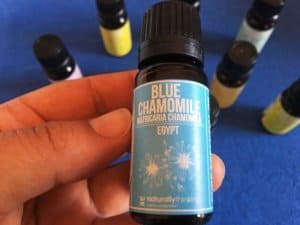 Blue chamomile, also known as German chamomile, comes from the herb you would be taking as a herbal tea (check it here).
Blue chamomile, also known as German chamomile, comes from the herb you would be taking as a herbal tea (check it here).
I really like this particular oil: the blue colour is intense and quite striking. I’ve added to skincare and it has power in it, I can feel it.
It has calming properties as well as being anti-inflammatory. A very good essential oil for eczema.
Botanical Name
Matricaria Recutita
General Info, Look, Aroma & Feel
This essential oil should be a deep blue. The liquid has viscosity to it. Bisabolol and apigenin are present in this essential oil which can work similarly to well known painkillers.
What is Roman Chamomile Essential Oil Good For?
- A calming and soothing oil with anti-inflammatory properties making this essential oil ideal for treating skin conditions helping relieve inflamed and itchy skin.
- A great essential oil for treating eczema.
- Helpful to relieve arthritis pain.
- Helps calm nerves as well as tension headaches making it ideal to promote sleep.
- Mildly astringent, helps to clean pores.
- Mild pain reliever
Best Used As
- Bath oil: (mix between 8 and 10 drops with 1 tbsp base oil, use to calm nerves and relax)
- Massage oil: (mix 16 to 26 drops to 2 tbsp base oil for a massage. It can help with back pain, period pains, ease insomnia, menstrual cramps).
- Skincare: (up to 1% of essential oil added to your cream and apply as usual – remember it is mildly astringent. You’ll need a very precise scale to measure this, here’s the one I use, make sure you keep the oil amount at 1% or less!).
- Compress: (a compress can help calm skin reactions).
Blends Well With
- Clary sage, lavender, bergamot, jasmine, geranium, tea tree, ylang ylang, rose, lemon, grapefruit
Safety Data
Non-toxic and non-irritant although it can cause dermatitis in some individuals.
More information from trusted sources, here, here, here, here and here.
[amazon box=”B00JS8X06Q” template=”list”]
3. Eucalyptus Essential Oil Profile, Properties, Uses and Benefits
General Profile

When it comes to the top 10 best essential oils we have to add eucalyptus essential oil to the list. The problem is that there actually are 4 different types of eucalyptus oil: smithi, citadora, radiata and globulus, each one of them with their particular properties – more info here.
The eucalyptus essential oil I’ll be talking about is eucalyptus globulus. Eucalyptus comes from Australia and is good for respiratory infections. Worth mentioning that eucalyptus citadora and eucalyptus globulus are both good insect repellents. Some general info about eucalyptus oil: a powerful antibiotic, a powerful decongestant, a good disinfectant, a pain-reliever, anti-bacterial, anti-viral, anti-fungal. Helps with arthritis pain. It is also uplifting and can help with fatigue. It has a ‘cleansing’ smell.
Botanical Name
Eucalyptus Globulus
General Info, Look, Aroma & Feel
Warming, antiseptic, great pain and aches reliever, heals mouth ulcers, helps with insect stings/bites, balances and tones skin, lifts depression feelings, helps increase concentration.
What is Eucalyptus Globulus Essential Oil Good For?
- Antiseptic: 1) To heal fungal and bacterial infections, wounds and soothe insect bites press against skin several times 2) Mix to make a spray for a sick-room 3) Add to a bath to relieve cystitis.
- Skin toner: If you want to cleanse and tone oily or acne-prone skin just just add a few drops to a facial steam.
- For pains and aches: Make an ointment with the essential oil or add to a carrier oil to help loosen muscles and joints that are tight and also to warm the area.
- To improve focus: This essential oil is great for clearing the mind and improve your concentration. It also helps if you have a headache.
Best Used As
- Massage: When feeling congested, to clear sinuses and help with sleep just add 2 or 3 drops to an ointment and rub on the chest.
- Inhalation: Use as facial steam to tone your skin and cleanse and unclog pores by adding 6 to 8 drops to the water. It also helps to refresh your mind.
- Diffuser: If you’re tired this oil will lift you up. Add 3 to 4 drops to your diffuser.
Blends Well With
- Citrus, marjoram, lavender, tea tree and woody and spicy oils
Safety Data
Non-toxic. Don’t use globulus if you’re pregnant or breastfeeding. Non-irritant when diluted (less than 20%). For children under the age of seven avoid near the nose or face.
More information from trusted sources here, here, here, and here.
[amazon box=”B0062C2G9S” template=”list”]
4. Tea Tree Essential Oil Profile, Properties, Uses and Benefits
General Profile
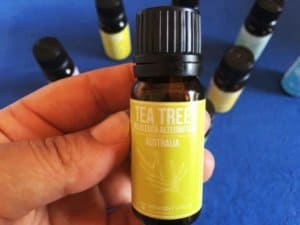 When I hear tea tree essential oil I automatically think “antiseptic”, with a pungent and really fresh smell. Tea tree is native to Australia; for thousands of years the Aborigines have treated infected wounds as well as fevers with the leaves of the plant. The oil is actually active in the three different infectious organisms: fungi, viruses and bacteria. I recently had a cold sore on the side of my mouth and treated it with neat tea tree oil (according to Neal’s Yard Remedies aromatherapy course it can actually be dabbed on neat to cold sores, verrucas and warts although Robert Tisserand disagrees by saying you should never use an essential oil neat, I personally heard him say this on an interview with Lorraine Dallmeier from Formula Botanica, as part of my Diploma in Organic Skincare Formulation course). Finally, just to mention this is a great oil to have as part of an essential oil first-aid kit.
When I hear tea tree essential oil I automatically think “antiseptic”, with a pungent and really fresh smell. Tea tree is native to Australia; for thousands of years the Aborigines have treated infected wounds as well as fevers with the leaves of the plant. The oil is actually active in the three different infectious organisms: fungi, viruses and bacteria. I recently had a cold sore on the side of my mouth and treated it with neat tea tree oil (according to Neal’s Yard Remedies aromatherapy course it can actually be dabbed on neat to cold sores, verrucas and warts although Robert Tisserand disagrees by saying you should never use an essential oil neat, I personally heard him say this on an interview with Lorraine Dallmeier from Formula Botanica, as part of my Diploma in Organic Skincare Formulation course). Finally, just to mention this is a great oil to have as part of an essential oil first-aid kit.
Botanical Name
Melaleuca Alternifolia
General Info, Look, Aroma & Feel
Pale yellow/greenish, pungent smell (I love it), fresh and potent (it smells ‘antiseptic’ if there’s such a smell).
What is Tea Tree Essential Oil Good For?
- Fights infection: cold sores, blisters, herpes, insect bites, warts and verrucas, infected wounds, abscess, ringworm, athlete’s foot and burns.
- Helps control acne: can be applied to acne spots, pimples, etc.
- Combats dandruff, greasy hair and head lice: use it as a scalp massage to help with dandruff and as a rinse to combat oily/greasy hair.
- Combats bad breath and mouth ulcers: use well diluted to treat mouth ulcers, infections of the gums and also bad breath.
- Combats strong odours: used in deodorants, sprays, creams, etc.
- Combats flu and cold symptoms: use as steam inhalation to ease congestion and help breathing. Good for asthma, catarrh, coughs, etc.
- Fights genital infections: cystitis, thrush, herpes, warts, etc.
- An emotional tonic: helps with anxiety and depression that are linked to chronic conditions. Helps with lethargy as well.
Best Used As
- First aid: Dab neat onto cold sores (again, please read my comment on Neal’s Yard Remedies and Robert Tisserand’s views around this topic above). Use a 10% dilution (1 part oil, 10 parts water) to clean infected wounds.
- To treat feet: Add around 20 drops of tea trea essential oil to a bucket of warm water and soak feet for around 15 minutes if they feel tired, hot, to treat athlete’s foot or even if they’re smelly.
Blends Well With
- Lavender, lemon, rosemary, lavandin, lavender, geranium, marjoram, clary sage, clove, nutmeg, eucalyptus, pine
Safety Data
Non-irritant in dilutions of less than 10 percent and non-toxic externally. Skin sensitisation possible in some people.
More information from trusted sources here, here, here and here.
[amazon box=”B0069SQRNG” template=”list”]
5. Rosemary Essential Oil Profile, Properties, Uses and Benefits
General Profile
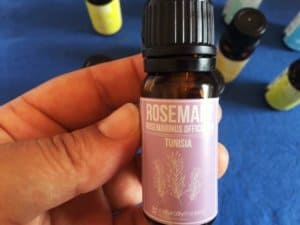 I use rosemary essential oil to clear my mind or focus/concentrate when working (I add 4 to 8 drops of this essential oil to my oil burner). It fights infection and relieves pain (it contains rosmarinic acid [1], [2], which is antibacterial / antifungal / anti-inflammatory). Native to the Mediterranean area, rosemary can help with a variety of ailments: liver congestion, rheumatic and muscular pain, hair problems, skin problems, respiratory and circulatory disorders. It has a beautiful, aromatic and strong smell.
I use rosemary essential oil to clear my mind or focus/concentrate when working (I add 4 to 8 drops of this essential oil to my oil burner). It fights infection and relieves pain (it contains rosmarinic acid [1], [2], which is antibacterial / antifungal / anti-inflammatory). Native to the Mediterranean area, rosemary can help with a variety of ailments: liver congestion, rheumatic and muscular pain, hair problems, skin problems, respiratory and circulatory disorders. It has a beautiful, aromatic and strong smell.
Botanical Name
Rosmarinus Officinalis
General Info, Look, Aroma & Feel
Virtually colourless, rosemary essential oil has a strong and fresh smell. I find that it can smell like ‘medicine’ (detoxifying as well as cleansing).
What is Rosemary Essential Oil Good For?
- Use neat oil on: bites, scabies to reduce inflammation and sores. (Please read my comment above regarding how Neal’s Yard Remedies and Robert Tisserand differ on using essential oils neat on skin).
- Other skincare uses: dandruff, acne, eczema, dermatitis, to repel insects, head lice, varicose veins.
- Combats hair loss and dandruff: use as a hair tonic to stimulate circulation which helps combat dandruff as well as hair loss.
- Detox: rosemary essential oil stimulates lymphatic and circulation systems.
- Aids circulation: treats low blood pressure and helps with pain from sprains/strains. After exercising it helps soothing sore muscles. Helps with rheumatism as well.
- Improves concentration/mental fatigue: helps to improve concentration, memory and mental clarity. If feeling tired or lethargic this oil will help.
Best Used As
- Massage oil: Add to creams/lotions to relieve pain (around 10 drops of rosemary essential oil to 1 tablespoon base cream or base oil).
Blends Well With
- Basil, pine, oregano, lavender, lavandin, thyme, peppermint, cedarwood, pine, petitgrain and cinnamon
Safety Data
Non-toxic, non-irritant when diluted, avoid using with epileptics.
More information from trusted sources here, here, here, here and here.
[amazon box=”B005V4ZMJ4″ template=”list”]
6. Lavender Essential Oil Profile, Properties, Uses and Benefits
General Profile
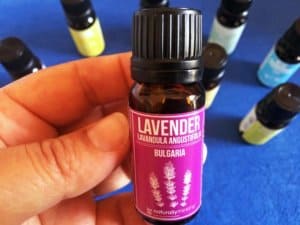 Also native to the Mediterranean region, there are many lavender varieties. In the Canary Islands we have our own Lavandula Canariensis. Lavender essential oil is really versatile and known of its calming effect.
Also native to the Mediterranean region, there are many lavender varieties. In the Canary Islands we have our own Lavandula Canariensis. Lavender essential oil is really versatile and known of its calming effect.
Lavender essential oil smells WONDERFUL and I’m ashamed to say I used to think it was an ‘oder person’s type of smell’. Having said that, I am getting older though…
This is a tonifying, balancing, revitalising and regulating oil. Safe for all ages as well as in pregnancy. A pain reliever and muscle-relaxant. Antimicrobial.
Botanical Name
Lavandula Angustifolia
General Info, Look, Aroma & Feel
Floral! Lovely, fresh and sweet; if ‘clean’ was a smell, this is it! Colourless, pale and yellowish.
What is Lavender Essential Oil Good For?
- For the skin: softens and conditions the skin. A great addition to creams, lotions and base oils as well as bath preparations.
- Remedy for bites, cuts and burns: Apply neat to burns, cuts and bites (please refer to my comment above regarding using essential oils neat).
- For acne: it can help ease acne and acne rosacea as well as eczema and psoriasis (and reducing scarring).
- For calming effects/sleep: This oil is deeply relaxing and can help reduce stress and anxiety.
- Mild analgesic/pain killer: helps relieve headaches & migraines (not the same!), sprains, sores, toothaches. Can help ease period related pain. It also helps with muscular/muscle pain.
- Antiseptic/antibacterial/anti-inflammatory: keeps ulcers, wounds and sores clean.
- Air freshener: wonderful as a room spray.
Best Used As
- Massage oil: Add 10 to 20 drops to around 2tbsp of any base oil.
- Bath oil: Add 10 to 12 drops to 1tbsp of any base oil.
Blends Well With
With about every other essential oil, particularly florals/citrus. I’ve used it with many different essential oils and it just worked with all of them. I love it.
Safety Data
Non-toxic, non-irritant, non-sensitising.
More information from trusted sources here, here, here and here.
[amazon box=”B007P70UKQ” template=”list”]
7. Geranium Essential Oil Profile, Properties, Uses and Benefits
General Profile
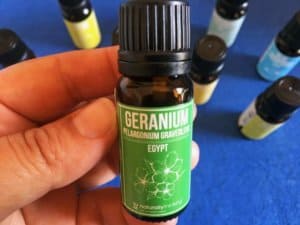 When it comes to top pure essential oils I must admit this is one of my favourites. I mix it with lavender and frankinsence to create a wonderful skincare cream that is suitable for all skin types (and the smell is simply divine). Native of South Africa, I must admit I wasn’t always keen on the flower (and still I’m not!) but I can appreciate the versatility of this essential oil and realise I need to keep a few bottles at hand, as it goes pretty quickly at home.
When it comes to top pure essential oils I must admit this is one of my favourites. I mix it with lavender and frankinsence to create a wonderful skincare cream that is suitable for all skin types (and the smell is simply divine). Native of South Africa, I must admit I wasn’t always keen on the flower (and still I’m not!) but I can appreciate the versatility of this essential oil and realise I need to keep a few bottles at hand, as it goes pretty quickly at home.
Geranium essential oils helps balance mood, skin and hormones. According to the Neal’s Yard aromatherapy course I’ve done this essential oils is a great emotional regulator and “good for those who take their feelings inwards and suppress their ‘unwanted’ emotions.” Good for children and adults alike, this essential oil can revive the skin when it has been irritated or damaged by the weather.
Botanical Name
Pelargonium Graveolens
General Info, Look, Aroma & Feel
Greenish oil, with a powerful scent (I don’t like the smell on its own that much but great when mixed into my skincare).
What is Geranium Essential Oil Good For?
- Detox: Helps the body to eliminate excess water due to its gentle diuretic effects.
- A great emotional balancer: it can both uplift and calm making it a natural antidepressant. Can help treat anxiety with children and adults.
- Mild analgesic/pain killer: can relieve neuralgia and shingles.
- Treats dandruff: can balance scalp and treat dandruff.
- Skincare: tonifying, this oil is good for all skin types. Helps control acne.
Best Used As
- Diffuser: Eases anxiety and helps feel lifted. Add 5 drops of geranium essential oil to a diffuser. Can mix with another 5 drops of orange essential oil (diffuser, oil burner or vaporiser).
- Bath oil: Add 5 drops of geranium essential oil to 1tbsp of a base oil. You can also add 5 drops of lavender essential oil.
Blends Well With
- Citrus, floral, spices and woody notes. Lavender, neroli, jasmine, juniper, patchouli, bergamot, sandalwood, rose, clove
Safety Data
Non-toxic, non-irritant in dilution, non-sensitising.
More information from trusted sources here, here and here.
[amazon box=”B00P2S88M2″ template=”list”]
8. Thyme Essential Oil Profile, Properties, Uses and Benefits
General Profile
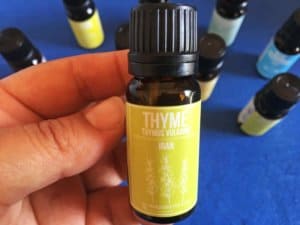 A fantastic essential oil for fighting colds in the winter. Native to the Mediterranean region.
A fantastic essential oil for fighting colds in the winter. Native to the Mediterranean region.
Thyme has been used in food, cosmetics, perfume and medicine for a long thyme.
Great for digestive problems, respiratory problems, muscle/joint pain, circulatory disorders and prevention and treatment of infection.
Botanical Name
Thymus Vulgaris
General Info, Look, Aroma & Feel
Member of the mint family, thyme essential oil has a clear clear, yellowy colour with a fresh and sweet fragrance.
What is Thyme Essential Oil Good For?
- Soothes coughs: Thyme essential oil has antiseptic and antipasmodic properties which makes it an ideal remedy for cold symptoms (sore throats and coughs).
- Fights fungal infection: You can massage the oil (dilute first) into the scalp, feet and nails for clearing dandruff, athletes foot, fungal nail infections or seborrheic dermatitis.
- Helps clear acne: According to some research thyme can be effective at combating acne.
- Aches/pain reliever: The essential oil can help relieve joint pain because of its warming effect, helping ease tight muscles.
- Helps with anxiety
- Improves circulation
- Helps with anaemia
- Can treat urinary infections (i.e. cystitis)
Best Used As
- Bath oil: Disperse in a hot bath if you want to treat urinary tract infections by adding 5 or 6 drops to 1 tablespoon of base oil.
- Skin toner: Blend 2 drops of thyme essential oil and 2 drops of mandarin essential oils into a base made of aloe vera juice and witch hazel water (around 2 tsp aloe vera juice and 3fl oz witch hazel water). Apply with a cotton ball.
Blends Well With
- Thyme essential oil blends well with eucalyptus, clove, tangerine, lavender, lemon, pine and bergamot essential oils
Safety Data
Always use well diluted at less than 2%.
More information from trusted sources here, here, here, here and here.
[amazon box=”B005Y4CX3O” template=”list”]
9. Lemon Essential Oil Profile, Properties, Uses and Benefits
General Profile
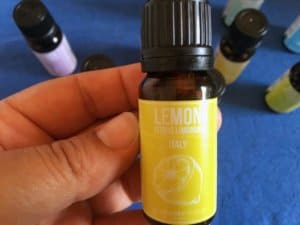 A wonderfully fresh essential oil, it can help clearing the mind as well as detoxify the skin. A great deodoriser because of its lovely, citrusy aroma as well as antiseptic properties. It makes a great massage oil.
A wonderfully fresh essential oil, it can help clearing the mind as well as detoxify the skin. A great deodoriser because of its lovely, citrusy aroma as well as antiseptic properties. It makes a great massage oil.
I personally like to mix lemon essential oil with geranium essential oil (5 drop of each on my diffuser) because of the uplifting effect lemon can have and the way geranium essential oil works on the mood (geranium essential oil is an emotional balancer, a natural antidepressant that can also help treat anxiety).
Botanical Name
Citrus Limon
General Info, Look, Aroma & Feel
Citrus smell, fresh and invigorating. Yellowy, greeny, pale oil.
What is Lemon Essential Oil Good For?
- Cleanses oil-prone skin: good for oil-prone skin as well as hair.
- Helps with varicose veins: Lemon essential oil boosts circulation helping reduce varicose veins.
- Antiseptic: Helps with boils and other skin eruptions. Apply neat on warts/verrucas (again, see my comment above regarding using essential oils neat on skin).
- A great detox: When using as part of an oil massage blend it helps with cleansing as well as reducing fluid retention and cellulite.
- Lifts your spirits: Great when you need mental focus and an uplift.
Best Used As
- Massage oil: to help detoxify the body
Safety Data
Use well diluted at less than 2%. Make sure to avoid using prior to sun exposure (12 hours).
More information from trusted sources here, here, here and here.
[amazon box=”B007P70U88″ template=”list”]
10. Peppermint Essential Oil Profile, Properties, Uses and Benefits
General Profile
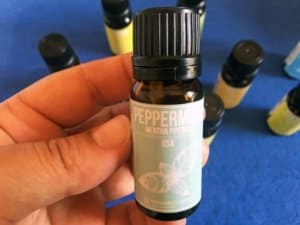 A refreshing, cooking essential oil with analgesic and antiseptic properties. Peppermint essential oil can be an effective remedy for muscular pains, headaches and neuralgia.
A refreshing, cooking essential oil with analgesic and antiseptic properties. Peppermint essential oil can be an effective remedy for muscular pains, headaches and neuralgia.
The most prominent chemical component of peppermint’s essential oil is ‘menthol’, which has a fantastic stimulating action on our respiratory system by opening respiratory channels.
Botanical Name
Mentha Piperita
General Info, Look, Aroma & Feel
Watery, thin oil with a sharp, strong, menthol sweet aroma. Colour is clear to pale yellow.
What is Peppermint Essential Oil Good For?
- Deodoriser: Fights body odour, with antiseptic properties. Helps combat bad breath.
- Tonic effects on the skin: Good for soothing irritated skin.
- Antiviral and antiseptic: Great for treating cold sores.
- Good for digestion: Use a peppermint essential oil blend to ease indigestion/improve digestion. It also helps if you have nausea as well as travel sickness (I suffer from travel sickness really badly).
- For stings and bites: Peppermint essential oil is an effective insect repellent, use it to help soothe mosquito bites.
- Can help relieve headaches.
- Expectorant that can help with coughs as well as clear sinuses.
Best Used As
- Massage oil: Blend with a carrier oil (1 or 2 drops peppermint essential oil to 1 tablespoon base oil) to massage the abdomen to help with digestion or nausea.
- Inhalation: Not for children or people who suffer with asthma. Add 3 or 4 drops to a diffuser, oil burner, vaporiser or as a steam inhalation and use to help clear sinuses and as a decongestant.
Blends Well With
- Eucalyptus, lemon, lavender, pine, rosemary
Safety Data
Use well diluted at less than 2%. Also avoid using near the nose in children under 7.
More information from trusted sources here, here and here.
[amazon box=”B0069SQEK2″ template=”list”]
Get Your Own Starter Pack/Kit
The above are the top 10 must have essential oils but if you prefer to buy an already prepared kit, below are a few options for you. Bear in mind that the essential oils might vary (you’ll get some of the oils above but other different ones as well) but you might also find that the price is good (I buy my wonderful essential oil sleeves from Naturally Thinking (1), I end up saving a lot of money).
Here’s my kit:
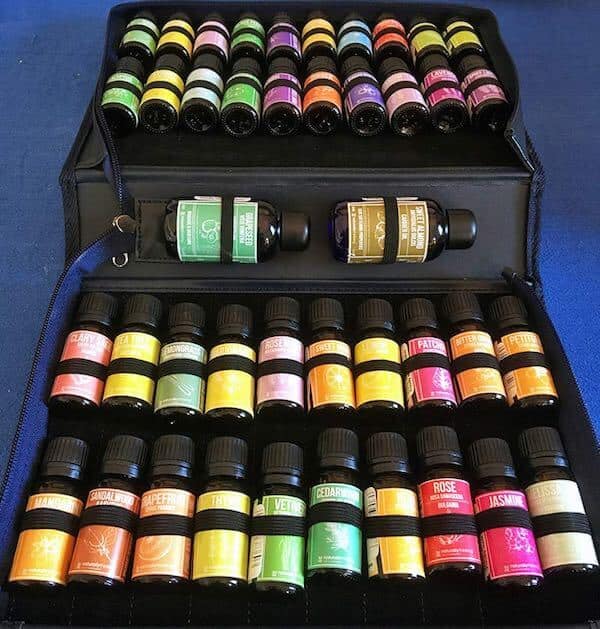

Wonderful, isn’t it?? : )
You don’t have to have such an expensive kit, you can get started just with a few oils or buy single ones from the list above top 10 essential oils and their uses kit and expand as you use them and learn about them. I personally felt I wanted to have the lot because being in the Canary Islands I can’t get a hold of a variety oils that easily and not everyone ships them, so there you go.
Great Essential Oil Starter Kits
See what you think of the kits below, they could work as an aromatherapy starter kit. I do think there’s something here for everyone for sure.
[amazon box=”B005IHJ556″]
[amazon boz=”B005YE0NF4″]
[amazon box=”B01161IL20″]
[amazon box=”B071RXT6N8″]
[amazon box=”B0128HRZOG”]
[amazon box=”B01MRNUPCD”]
[amazon box=”B06X3RL7TS”]
[amazon box=”B06X6BJD2Q”]
Final Thoughts
There you have it. The top 10 must-have essential oils to get you started as well as a list of kits that might be useful if you prefer to buy an already prepared starter kit.
I hope you’ve enjoyed the choices and, again, remember to take it slowly by finding basic useful uses at first and slowly getting into the habit of using them. In no time, you’ll be using essential oils every day, like I do : )
Resources:
Roman Chamomile Essential Oil:
https://www.ncbi.nlm.nih.gov/pmc/articles/PMC2995283/
https://articles.mercola.com/herbal-oils/roman-chamomile-oil.aspx
German Chamomile Essential Oil:
https://articles.mercola.com/herbal-oils/german-chamomile-oil.aspx
https://www.webmd.com/vitamins/ai/ingredientmono-951/german-chamomile
https://www.ncbi.nlm.nih.gov/pmc/articles/PMC2995283/
http://japsonline.com/admin/php/uploads/288_pdf.pdf
https://www.ncbi.nlm.nih.gov/pubmed/25666499
Eucalyptus Essential Oil:
https://articles.mercola.com/herbal-oils/eucalyptus-oil.aspx
https://www.newdirectionsaromatics.com/blog/products/all-about-eucalyptus-oil.html
http://www.aromatherapy.com/most_popular.html
https://www.medicalnewstoday.com/articles/266580.php
Tea Tree Essential Oil:
https://www.healthline.com/nutrition/tea-tree-oil
https://www.webmd.com/vitamins/ai/ingredientmono-113/tea-tree-oil
https://www.medicalnewstoday.com/articles/262944.php
https://www.ncbi.nlm.nih.gov/pmc/articles/PMC1360273/
Rosemary Essential Oil:
https://articles.mercola.com/herbal-oils/rosemary-oil.aspx
https://www.medicalnewstoday.com/articles/266370.php
https://www.ncbi.nlm.nih.gov/pmc/articles/PMC4749867/
https://www.aromaweb.com/essential-oils/rosemary-oil.asp
https://www.webmd.com/vitamins/ai/ingredientmono-154/rosemary
Lavender Essential Oil:
http://www.centralcoastlavender.com/healing-power-of-lavender/
https://www.medicalnewstoday.com/articles/265922.php
https://articles.mercola.com/herbal-oils/lavender-oil.aspx
https://www.newdirectionsaromatics.com/blog/products/all-about-lavender-oil.html
Geranium Essential Oil:
https://articles.mercola.com/herbal-oils/geranium-oil.aspx
https://www.newdirectionsaromatics.com/blog/products/all-about-geranium-oil.html
https://www.aromaweb.com/essential-oils/geranium-oil.asp
Thyme Essential Oil:
https://articles.mercola.com/herbal-oils/thyme-oil.aspx
https://www.medicalnewstoday.com/articles/266016.php
http://www.floracopeia.com/Essential-Oils/essential-oils-sub/organic-thyme-oil.html
https://www.doterra.com/US/en/blog/spotlight-thyme-oil
https://www.webmd.com/vitamins/ai/ingredientmono-823/thyme
Lemon Essential Oil:
https://articles.mercola.com/herbal-oils/lemon-oil.aspx
https://oilhealthbenefits.com/lemon-essential-oil/
http://www.floracopeia.com/Essential-Oils/essential-oils-sub/organic-lemon-oil.html
https://www.newdirectionsaromatics.com/blog/products/all-about-lemon-oil.html
Peppermint Essential Oil:
https://www.newdirectionsaromatics.com/blog/products/all-about-peppermint-oil.html
https://www.webmd.com/a-to-z-guides/peppermint-oil-uses-benefits-effects#1
https://articles.mercola.com/herbal-oils/peppermint-oil.aspx
Keywords: top essential oils, best essential oils, chamomile essential oil, eucalyptus essential oil, tea tree essential oil, rosemary essential oil, lavender essential oil, geranium essential oil, thyme essential oil, lemon essential oil, clove bud essential oil, where to buy essential oils, top essential oils to have, top essential oils to have on hand, top pure essential oils, top 10 best essential oils, what are the top essential oils, top 10 must have essential oils, top must have essential oils, top 10 essential oils and their uses, top essential oils and their benefits, top 10 most useful essential oils, top essential oils to buy, the top essential oils, top 10 pure essential oils, top essential oils and uses, top essential oils and their uses
